Danielle Ellison's Blog, page 2
November 20, 2025
OEKO-TEX Certification: Chemical Safety, Standards and Consumer Assurance
OEKO-TEX Certification is an internationally recognized standard that guarantees textiles and leather products are free from harmful chemicals. By rigorously testing for toxic substances, it provides consumers with confidence in the safety and sustainability of their purchases, promoting healthier choices in apparel and home textiles.

OEKO-TEX Certification is a globally recognized standard that ensures textiles and leather products are free from harmful substances. It provides consumers with assurance regarding the chemical safety of the products they purchase.
Definition of OEKO-TEX CertificationOEKO-TEX Certification encompasses several testing and certification systems for textiles, including the Standard 100 and Made in Green labels. These certifications evaluate products for harmful chemicals, ensuring they meet specific safety criteria set by the OEKO-TEX Association.
The certification process involves rigorous testing of raw materials, intermediate and end products, as well as the production processes. Products that pass these tests are labeled, allowing consumers to identify safe options easily.
Importance for consumersOEKO-TEX Certification is crucial for consumers seeking safe and environmentally friendly textile products. It helps them make informed choices, reducing the risk of exposure to harmful chemicals that can affect health and well-being.
By choosing OEKO-TEX certified products, consumers can trust that the items they buy, such as clothing and home textiles, have been tested for safety and adhere to strict environmental standards. This certification can also enhance brand loyalty, as consumers increasingly prioritize sustainability and safety in their purchasing decisions.

OEKO-TEX Certification ensures chemical safety by rigorously testing textiles for harmful substances and adhering to strict international standards. This certification provides consumers with assurance that products are free from toxic chemicals, promoting safer choices in apparel and home textiles.
Testing for harmful substancesOEKO-TEX conducts comprehensive testing for a wide range of harmful substances, including heavy metals, pesticides, and formaldehyde. Each product undergoes a thorough examination to ensure it meets safety criteria, which helps prevent health risks associated with chemical exposure.
Testing is performed in accredited laboratories and follows a standardized methodology. Products that pass these tests receive certification, indicating they are safe for human use, which is particularly important for items in direct contact with skin.
Compliance with international standardsOEKO-TEX Certification aligns with several well-known international standards, such as REACH in Europe and CPSIA in the United States. These regulations set limits on harmful substances, ensuring that certified products comply with global safety requirements.
By adhering to these standards, OEKO-TEX not only enhances consumer trust but also supports manufacturers in meeting legal obligations. This compliance helps brands differentiate themselves in the market, appealing to increasingly health-conscious consumers.

OEKO-TEX certification levels include various standards that assess textile products for harmful substances, ensuring safety and sustainability. The main certifications focus on different aspects of chemical safety, with each level providing specific assurances to consumers and manufacturers.
OEKO-TEX Standard 100OEKO-TEX Standard 100 is a globally recognized certification for textiles, ensuring that products are free from harmful substances. It applies to all stages of production, from raw materials to finished goods, and includes rigorous testing for over 100 harmful chemicals.
Products certified under this standard are categorized into four classes based on their intended use, such as baby products or items in direct skin contact. This classification helps consumers make informed choices based on safety levels appropriate for different age groups and sensitivities.
OEKO-TEX Made in GreenOEKO-TEX Made in Green certification indicates that a product is made from safe materials and produced in environmentally friendly facilities. This certification combines the principles of OEKO-TEX Standard 100 with additional criteria related to sustainable production practices.
To obtain this certification, manufacturers must provide transparency about their supply chain and production processes. This includes adherence to social responsibility standards, ensuring fair working conditions and environmental protection, which appeals to consumers seeking ethically produced goods.

Consumers can identify OEKO-TEX certified products by looking for specific labels on packaging or product listings. These labels indicate that the items meet stringent chemical safety standards, ensuring they are free from harmful substances.
Labeling on product packagingOEKO-TEX certified products typically display a label on their packaging, such as the OEKO-TEX Standard 100 label. This label often includes a unique certification number that consumers can verify online to confirm the product’s compliance with safety standards.
When shopping, look for labels that mention “OEKO-TEX” alongside terms like “tested for harmful substances.” This indicates that the product has undergone rigorous testing for potentially harmful chemicals.
Online product listingsMany online retailers provide information about OEKO-TEX certification in their product descriptions. Check for mentions of OEKO-TEX certification in the product details, which may include the specific standard it meets, such as Standard 100 or Made in Green.
Additionally, reputable brands often include links to their OEKO-TEX certification on their websites, allowing consumers to verify the authenticity of the certification. Always ensure the product listing is from a trusted source to avoid misleading claims.

OEKO-TEX certification offers brands significant advantages, including improved product appeal and assurance of chemical safety. By adhering to these standards, brands can differentiate themselves in a competitive market while ensuring consumer safety and compliance with regulations.
Enhanced marketabilityBrands with OEKO-TEX certification can effectively market their products as safe and environmentally friendly. This certification serves as a valuable selling point, especially in markets where consumers are increasingly concerned about sustainability and chemical exposure.
For example, textiles labeled with OEKO-TEX can attract eco-conscious consumers, potentially leading to higher sales. Brands can leverage this certification in advertising campaigns, emphasizing their commitment to quality and safety.
Consumer trust and loyaltyOEKO-TEX certification fosters consumer trust by ensuring that products are free from harmful substances. When customers see this certification, they are more likely to feel confident in their purchase decisions, knowing that the brand prioritizes their health and safety.
Building loyalty is easier for brands that consistently offer OEKO-TEX certified products. Repeat customers may be willing to pay a premium for products that guarantee safety and sustainability, enhancing long-term brand loyalty and customer relationships.

OEKO-TEX certification significantly influences e-commerce by assuring consumers of product safety and sustainability. This certification helps online retailers build trust and credibility, ultimately leading to increased customer loyalty and sales.
Increased sales potentialProducts with OEKO-TEX certification often experience higher sales potential due to growing consumer demand for safe and eco-friendly items. Shoppers are increasingly willing to pay a premium for certified goods, which can lead to improved profit margins for e-commerce businesses.
For instance, brands that highlight their OEKO-TEX certification in product descriptions and marketing materials can attract a broader audience. This can be particularly effective in markets like the European Union, where sustainability is a key purchasing factor.
Competitive differentiationOEKO-TEX certification serves as a powerful tool for competitive differentiation in the crowded e-commerce landscape. By showcasing compliance with rigorous safety standards, brands can set themselves apart from competitors who may not prioritize chemical safety.
Retailers can leverage this certification in their branding strategies, emphasizing their commitment to consumer health and environmental responsibility. This approach not only enhances brand image but also fosters customer loyalty, as consumers increasingly prefer brands that align with their values.

To obtain OEKO-TEX certification, products must meet specific criteria related to chemical safety and quality management. This involves compliance with chemical regulations and the implementation of robust quality management systems.
Compliance with chemical regulationsCompliance with chemical regulations is crucial for OEKO-TEX certification. Products must adhere to various international and national standards regarding harmful substances, including the REACH regulation in Europe and other relevant guidelines. This ensures that textiles are free from harmful chemicals that could pose risks to human health and the environment.
Manufacturers should conduct thorough assessments of their materials and processes to confirm compliance. Regular testing and documentation are essential to demonstrate adherence to these regulations, which may vary by region. For example, certain chemicals may be restricted in the EU but allowed in other markets.
Quality management systemsImplementing a quality management system (QMS) is another prerequisite for OEKO-TEX certification. A QMS helps organizations systematically manage their processes and ensure consistent product quality. This includes establishing protocols for monitoring and controlling production processes to minimize defects and ensure compliance with OEKO-TEX standards.
Companies should consider adopting internationally recognized standards, such as ISO 9001, to enhance their QMS. Regular audits and reviews of the system can help identify areas for improvement and maintain certification. A well-structured QMS not only supports OEKO-TEX certification but also boosts overall operational efficiency.

Emerging trends in OEKO-TEX certification focus on increasing consumer demand for sustainable and safe textile products. As awareness of environmental and health issues grows, brands are adapting their practices to meet these expectations through enhanced certification processes.
Focus on sustainabilitySustainability is becoming a cornerstone of OEKO-TEX certification, with brands prioritizing eco-friendly materials and production methods. This trend includes the use of organic fibers, recycled materials, and reduced water and energy consumption during manufacturing.
Companies are increasingly adopting the OEKO-TEX Standard 100 and the OEKO-TEX Made in Green label, which not only ensure chemical safety but also verify sustainable production practices. This dual focus helps brands appeal to environmentally conscious consumers.
To align with sustainability trends, brands should consider conducting regular audits of their supply chains and materials. Implementing transparent reporting practices can enhance consumer trust and demonstrate commitment to environmental responsibility.
Slow Fashion: Impact on Choices, Values and Sustainability
Slow fashion is reshaping consumer behavior by encouraging a thoughtful and intentional approach to clothing purchases. By emphasizing sustainability, ethical labor practices, and timeless design, it inspires individuals to make choices that positively impact both the environment and society. This movement prioritizes quality over quantity, fostering responsible consumption and reducing waste in the fashion industry.

Slow fashion significantly influences consumer choices by promoting a mindful approach to clothing purchases. It encourages individuals to consider the environmental and social implications of their fashion decisions, leading to more deliberate and informed buying habits.
Increased awareness of sustainabilitySlow fashion fosters a heightened awareness of sustainability among consumers. This movement emphasizes the environmental impact of clothing production, urging shoppers to seek out sustainable materials and practices.
As a result, many consumers now prioritize brands that utilize eco-friendly fabrics, reduce waste, and implement ethical manufacturing processes. This shift often leads to a preference for local and small-scale production over mass-market options.
Preference for ethical brandsConsumers influenced by slow fashion increasingly favor ethical brands that align with their values. These brands often prioritize fair labor practices, transparency in sourcing, and community engagement.
Shoppers are more likely to support companies that provide information about their supply chains and demonstrate a commitment to social responsibility, even if it means paying a premium for their products.
Shift towards quality over quantitySlow fashion encourages a shift from quantity to quality in consumer purchases. Instead of buying numerous low-cost items, consumers are now more inclined to invest in fewer, higher-quality pieces that offer durability and timeless style.
This change not only reduces waste but also promotes a more thoughtful wardrobe, where each item is chosen for its longevity and versatility. Shoppers are advised to consider the craftsmanship and materials of garments, ensuring they make purchases that will last.

The slow fashion movement is driven by values that prioritize sustainability, ethical labor practices, and timeless design. These principles encourage consumers to make thoughtful choices that positively impact the environment and society.
Commitment to environmental sustainabilityEnvironmental sustainability in slow fashion focuses on reducing waste and minimizing the carbon footprint of clothing production. Brands often use organic materials, eco-friendly dyes, and sustainable manufacturing processes to lessen their impact on the planet.
Consumers can support this commitment by choosing brands that prioritize sustainable practices, such as those that offer clothing made from recycled materials or those that implement take-back programs to recycle old garments. Look for certifications like GOTS (Global Organic Textile Standard) or OEKO-TEX to ensure environmental responsibility.
Support for fair labor practicesFair labor practices are essential to the slow fashion movement, ensuring that workers receive fair wages and safe working conditions. This value promotes transparency in the supply chain, encouraging brands to disclose where and how their products are made.
When shopping, consider brands that are certified by organizations like Fair Trade or those that provide information about their labor practices. Supporting local artisans and small-scale producers can also contribute to fair labor practices, as it often leads to better working conditions and economic stability in communities.
Emphasis on timeless designTimeless design in slow fashion emphasizes creating clothing that transcends trends, promoting longevity and versatility. This approach encourages consumers to invest in high-quality pieces that can be worn across seasons and occasions, reducing the need for frequent purchases.
To embrace timeless design, look for classic silhouettes and neutral colors that can be easily mixed and matched. Avoid fast fashion trends that quickly go out of style, and consider building a capsule wardrobe with versatile staples that reflect your personal style while supporting sustainable practices.
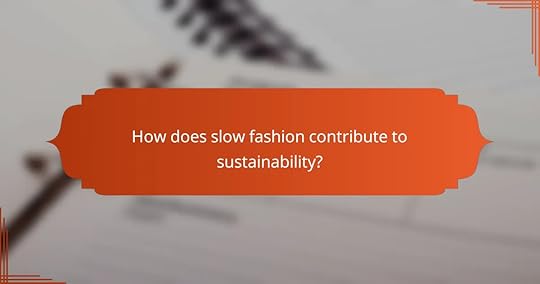
Slow fashion contributes to sustainability by emphasizing quality over quantity, which leads to reduced environmental impact. By prioritizing ethical production practices and long-lasting garments, slow fashion minimizes waste and promotes a more responsible consumption model.
Reduction of waste in the fashion industrySlow fashion significantly reduces waste in the fashion industry by encouraging consumers to buy fewer, higher-quality items. This approach contrasts with fast fashion, which often results in discarded clothing due to poor quality and rapid trends.
Brands that adopt slow fashion principles often implement strategies such as made-to-order production and limited collections, which help to minimize overproduction. For example, a brand might produce only a small batch of a particular design, ensuring that each piece is sold and utilized.
Use of eco-friendly materialsUsing eco-friendly materials is a cornerstone of slow fashion, as it prioritizes sustainable fabrics like organic cotton, hemp, and recycled materials. These alternatives typically have a lower environmental footprint compared to conventional textiles, which often rely on harmful pesticides and non-renewable resources.
Consumers can look for certifications such as GOTS (Global Organic Textile Standard) or OEKO-TEX, which indicate that the materials meet specific environmental and social criteria. Choosing garments made from these materials supports sustainable practices and reduces the overall impact on the planet.
Promotion of circular economy practicesSlow fashion promotes circular economy practices by encouraging the reuse, repair, and recycling of clothing. This model aims to extend the lifecycle of garments, reducing the need for new resources and minimizing waste.
Brands may offer repair services or take-back programs, allowing customers to return old items for recycling or refurbishment. By participating in these initiatives, consumers can contribute to a more sustainable fashion ecosystem and reduce their overall environmental impact.
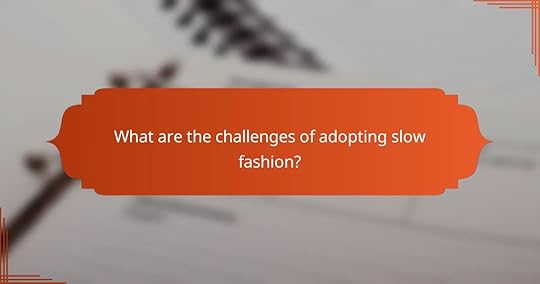
Adopting slow fashion presents several challenges that can deter consumers from making sustainable choices. These include higher costs, limited product availability, and common misconceptions about what slow fashion entails.
Higher price points for consumersOne significant challenge of slow fashion is the higher price point compared to fast fashion. This is often due to the use of quality materials, ethical labor practices, and sustainable production methods. Consumers may find that investing in a few high-quality pieces is more cost-effective in the long run, as these items tend to last longer than cheaper alternatives.
For example, a well-made garment from a slow fashion brand might cost between $100 to $300, while a similar item from a fast fashion retailer could be priced under $50. This initial investment can be a barrier for many, but it aligns with the values of sustainability and ethical consumption.
Limited availability of productsSlow fashion brands often produce limited quantities of their items, which can make finding specific products challenging. This scarcity can lead to frustration for consumers who prefer a wider selection or immediate availability. Unlike fast fashion, which churns out new styles frequently, slow fashion focuses on timeless designs that may not always be in stock.
Shoppers may need to plan ahead and be patient, as popular items can sell out quickly. Joining mailing lists or following brands on social media can help consumers stay informed about restocks and new releases.
Consumer misconceptions about slow fashionMany consumers hold misconceptions about slow fashion, believing it to be overly expensive or limited to niche markets. This misunderstanding can prevent them from exploring sustainable options that fit their lifestyle. In reality, slow fashion encompasses a wide range of styles and price points, making it accessible to various demographics.
Education is key to overcoming these misconceptions. Consumers should research brands and their practices, as many slow fashion companies offer affordable options without compromising on ethics or quality. Engaging with communities focused on sustainable living can also provide valuable insights and support.

Consumers can support slow fashion brands by making intentional purchasing decisions that prioritize sustainability, quality, and ethical practices. This involves choosing brands that align with these values and actively participating in community-driven initiatives.
Choosing sustainable clothing optionsWhen selecting clothing, opt for items made from organic or recycled materials, which have a lower environmental impact. Look for certifications such as GOTS (Global Organic Textile Standard) or OEKO-TEX, which indicate adherence to sustainability standards.
Consider the longevity of the garments; investing in higher-quality pieces that last longer can reduce overall consumption. Aim for versatile items that can be mixed and matched, minimizing the need for excessive purchases.
Participating in clothing swapsClothing swaps are a practical way to refresh your wardrobe without buying new items. Organize or join local events where participants exchange gently used clothing, promoting a circular economy and reducing waste.
These swaps not only save money but also foster community connections. Check local social media groups or community centers for upcoming events, and consider hosting your own swap to engage friends and neighbors.
Supporting local artisans and designersBuying from local artisans and designers helps sustain local economies and promotes unique, handcrafted items. Seek out local markets, boutiques, or online platforms that feature these creators, ensuring your purchases support ethical practices.
Engaging with local fashion events or workshops can deepen your understanding of the craftsmanship involved. This not only enhances your appreciation for the items but also strengthens community ties and supports sustainable practices in your area.
Fashion Swaps: Community, Sustainability and Cost Savings
Fashion swaps are a creative solution for fostering sustainability within urban communities by allowing individuals to exchange clothing, which reduces waste and the need for new garments. These events not only encourage eco-friendly practices but also enhance community connections through a shared passion for fashion and environmental stewardship. Additionally, participants can enjoy significant cost savings by refreshing their wardrobes without the financial burden of purchasing new items.
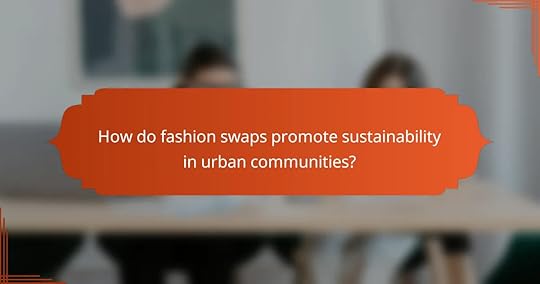
Fashion swaps foster sustainability in urban communities by facilitating the exchange of clothing, thereby reducing the demand for new garments and minimizing waste. These events not only promote eco-friendly practices but also strengthen community ties through shared interests in fashion and environmental responsibility.
Reduction of textile wasteFashion swaps directly contribute to the reduction of textile waste by encouraging participants to exchange items they no longer wear instead of discarding them. This practice helps divert clothing from landfills, where textiles can take years to decompose, and reduces the overall consumption of new materials.
By participating in swaps, individuals can clear out their closets while ensuring that their unwanted items find new homes. This cycle of reuse significantly lowers the environmental impact associated with the production and disposal of clothing.
Encouragement of circular fashionCircular fashion is a model that promotes the continuous use of resources, and fashion swaps are a practical embodiment of this concept. By facilitating the exchange of garments, these events encourage a shift away from the traditional linear model of ‘buy-use-dispose’ towards a more sustainable approach.
Participants in fashion swaps not only refresh their wardrobes but also contribute to a culture that values longevity and sustainability in clothing. This shift can inspire others in the community to rethink their consumption habits and embrace more sustainable choices.
Community engagement initiativesFashion swaps serve as community engagement initiatives that bring people together around a common goal of sustainability. These events often include workshops or discussions on sustainable fashion practices, further educating participants on the importance of reducing waste.
Organizing a fashion swap can be a straightforward process, often involving local venues such as community centers or parks. Collaborating with local businesses or organizations can enhance the event, providing resources and attracting a larger audience, thereby amplifying the impact on community awareness and participation.
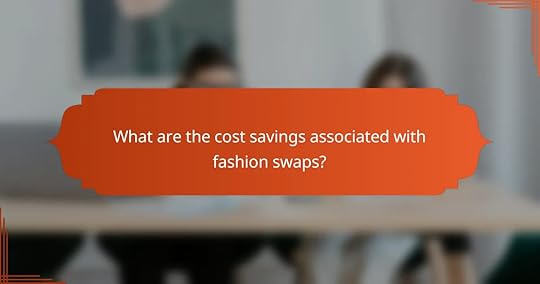
Fashion swaps can lead to significant cost savings by eliminating purchase costs and providing access to high-quality items without the usual expenses. Participants can refresh their wardrobes without spending money, making it an economical choice for sustainable fashion enthusiasts.
No purchase costsOne of the primary savings from fashion swaps is the absence of purchase costs. Instead of buying new clothes, participants exchange items they no longer wear, effectively acquiring new pieces for free. This model encourages a circular economy where clothing is reused rather than discarded.
By participating in swaps, individuals can save hundreds of dollars annually, depending on their clothing needs and the frequency of events. This approach not only benefits personal finances but also reduces waste in landfills.
Access to high-quality itemsFashion swaps often feature high-quality items that may be out of reach for many consumers when purchased new. Participants can find designer pieces, gently used clothing, and unique items that enhance their wardrobe without the hefty price tag. This access to premium goods is a major draw for many swap attendees.
Moreover, the variety available at swaps can lead to discovering new styles and brands that participants might not have considered otherwise. This exposure can enhance personal style while keeping costs low.
Reduced clothing expensesEngaging in fashion swaps can significantly reduce overall clothing expenses. By regularly swapping items, individuals can maintain a fresh wardrobe without the continuous financial outlay associated with shopping. This practice encourages mindful consumption and helps individuals prioritize quality over quantity.
Additionally, participants can save on related costs such as shipping fees or taxes that often accompany online purchases. By focusing on swapping, individuals can enjoy a diverse wardrobe while keeping their budgets intact.

To organize a successful fashion swap event, focus on clear guidelines, an appropriate venue, and effective promotion. These elements ensure a smooth experience for participants and maximize the benefits of community engagement and sustainability.
Set clear guidelinesEstablishing clear guidelines is essential for a successful fashion swap. Define what items can be swapped, such as clothing, accessories, or shoes, and set a limit on the number of items each participant can bring. This helps maintain organization and ensures everyone has a fair chance to find something new.
Consider including quality standards to ensure that items are in good condition. For instance, items should be clean and free of significant wear or damage. Communicating these guidelines in advance helps participants prepare and contributes to a positive experience.
Choose a suitable venueSelecting the right venue is crucial for accommodating participants and their items. Look for a space that is spacious enough to allow for easy browsing and swapping, such as a community center, local park, or even a large living room for smaller gatherings. Ensure the venue is accessible to all participants.
Consider the logistics of the venue, including seating, tables for displaying items, and facilities like restrooms. A comfortable environment encourages participants to stay longer and engage more fully in the event.
Promote through social mediaUtilizing social media is an effective way to promote your fashion swap event and attract participants. Create an event page on platforms like Facebook or Instagram, and share engaging content that highlights the benefits of swapping, such as sustainability and cost savings.
Encourage participants to share the event with their networks, and consider using local community groups to reach a wider audience. Posting reminders as the event date approaches can help maintain interest and ensure a good turnout.

Fashion swaps often involve a variety of items, primarily focusing on clothing, accessories, and seasonal items. Participants bring items they no longer need and exchange them for new-to-them pieces, promoting sustainability and community engagement.
Clothing for all agesClothing swaps cater to all age groups, from infants to adults. Common items include shirts, dresses, pants, and outerwear, allowing families to refresh their wardrobes without spending money. When participating, consider the condition and style of your items to ensure they appeal to a broad audience.
To maximize your experience, focus on popular sizes and styles that are in demand. Items that are trendy or classic tend to attract more interest, while worn-out or outdated pieces may not find new homes.
Accessories and shoesAccessories and shoes are essential components of fashion swaps, as they can significantly enhance an outfit. Commonly exchanged items include bags, belts, jewelry, and footwear. These items often have a longer lifespan than clothing, making them valuable for swapping.
When bringing accessories and shoes, ensure they are clean and in good condition. High-quality items or those from well-known brands can be particularly appealing to other participants, increasing the likelihood of a successful exchange.
Seasonal itemsSeasonal items, such as winter coats, summer dresses, or holiday-themed apparel, are frequently swapped during specific times of the year. These items can be bulky and costly, making swaps an excellent way to refresh your seasonal wardrobe without overspending.
When participating in seasonal swaps, timing is crucial. Organize or attend swaps just before the start of a new season to ensure a wide selection of relevant items. Additionally, consider the local climate and trends to choose items that will be in demand.
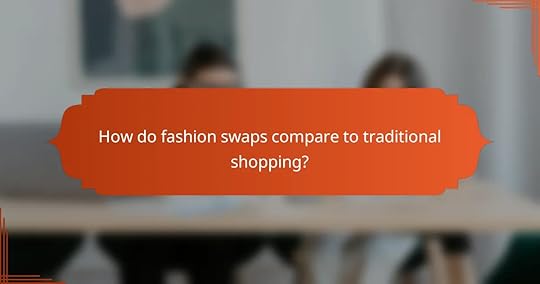
Fashion swaps offer a sustainable alternative to traditional shopping by allowing individuals to exchange clothing items rather than purchasing new ones. This practice not only reduces waste but also fosters a sense of community among participants.
Environmental impactFashion swaps significantly lower the environmental footprint associated with clothing production and disposal. By participating in swaps, individuals help reduce textile waste, which is a major contributor to landfill overflow and greenhouse gas emissions.
Moreover, the production of new clothing often involves high water usage and chemical processes. Swapping garments helps mitigate these impacts by extending the life cycle of existing items, promoting a more sustainable approach to fashion.
Community buildingFashion swaps create opportunities for social interaction and community engagement. Participants can meet like-minded individuals who share an interest in sustainable fashion, fostering connections that extend beyond the event itself.
These gatherings often include activities like styling sessions or workshops, enhancing the sense of community and encouraging participants to share tips on sustainable living and fashion choices.
Cost-effectivenessFashion swaps are a cost-effective way to refresh your wardrobe without spending money. Participants can exchange items they no longer wear for new-to-them pieces, effectively allowing them to update their style at little to no cost.
In contrast to traditional shopping, where clothing prices can vary widely, swaps typically operate on a no-cost basis, making them an attractive option for budget-conscious individuals. This approach not only saves money but also promotes a more mindful consumption of fashion.
November 19, 2025
Sustainable Fashion Choices: Budgeting, Quality and Eco-Friendly Options
Sustainable fashion is increasingly accessible for budget-conscious shoppers, offering stylish options that prioritize both affordability and eco-friendliness. By focusing on brands committed to ethical practices, such as Patagonia and Everlane, consumers can make informed choices that align with their values while maintaining a fashionable wardrobe. Budgeting for these purchases involves setting a realistic monthly spending limit, allowing for a responsible approach to building a sustainable collection.

Budget-conscious shoppers can find sustainable fashion options that balance affordability and eco-friendliness. Brands like Patagonia, Everlane, Reformation, H&M Conscious Collection, and ASOS Eco Edit offer stylish choices while prioritizing ethical practices and environmental responsibility.
PatagoniaPatagonia is renowned for its commitment to environmental sustainability and ethical labor practices. The brand offers a range of outdoor clothing that is durable and made from recycled materials, making it a solid choice for budget-conscious shoppers looking for quality.
While Patagonia’s prices can be higher than fast fashion, their products are designed to last, reducing the need for frequent replacements. Look for sales or their Worn Wear program, which offers used items at lower prices.
EverlaneEverlane focuses on transparency in pricing and production, providing high-quality basics at reasonable prices. The brand’s commitment to ethical factories and sustainable materials makes it a great option for those wanting to shop responsibly.
Everlane frequently offers promotions, and their “Choose What You Pay” model allows shoppers to select from different price points for certain items, making it easier to stick to a budget while still purchasing sustainable fashion.
ReformationReformation is a popular choice for trendy, eco-friendly clothing that appeals to younger consumers. The brand uses sustainable materials and practices, ensuring that their garments have a lower environmental impact.
Although some items can be on the pricier side, Reformation often has sales and offers a range of price points, making it possible to find stylish pieces without overspending.
H&M Conscious CollectionThe H&M Conscious Collection features clothing made from organic and recycled materials, providing budget-friendly sustainable options within a well-known fast fashion brand. This line aims to reduce environmental impact while offering trendy styles.
Prices are generally accessible, but shoppers should be mindful of the overall sustainability of their purchases, as the broader H&M brand still engages in fast fashion practices. Look for items labeled as part of the Conscious Collection for more eco-friendly choices.
ASOS Eco EditASOS Eco Edit curates a selection of sustainable fashion from various brands, making it easier for shoppers to find eco-friendly options in one place. The collection includes clothing made from organic cotton, recycled materials, and more.
ASOS frequently runs sales and offers a wide range of styles and prices, making it a convenient choice for budget-conscious shoppers looking for sustainable fashion. Keep an eye out for discounts and promotions to maximize savings.

To budget for sustainable fashion purchases, start by determining how much you can realistically spend each month while prioritizing eco-friendly options. This approach helps you make informed choices without overspending, ensuring that your wardrobe remains both stylish and sustainable.
Set a monthly spending limitEstablishing a monthly spending limit is crucial for maintaining control over your sustainable fashion budget. Consider your overall financial situation and decide on a reasonable amount that you can allocate specifically for clothing. A common range might be between 50 to 150 USD, depending on your income and other expenses.
Once you set this limit, track your purchases to ensure you stay within budget. Use budgeting apps or simple spreadsheets to monitor your spending habits and adjust your limit as needed based on your financial goals.
Prioritize quality over quantityFocusing on quality rather than quantity is essential for sustainable fashion. High-quality garments tend to last longer, reducing the need for frequent replacements and minimizing waste. Look for items made from durable materials, such as organic cotton, linen, or recycled fabrics.
When shopping, consider the cost-per-wear of an item. A higher-priced, well-made piece may be more economical in the long run compared to cheaper, lower-quality alternatives that wear out quickly. Aim to build a versatile wardrobe with timeless pieces that can be mixed and matched.
Utilize thrift stores and second-hand shopsThrift stores and second-hand shops are excellent resources for budget-friendly sustainable fashion. These venues often offer a wide variety of unique items at significantly lower prices than new retail options. Shopping second-hand not only saves money but also supports a circular economy by extending the life of clothing.
When visiting these stores, keep an open mind and be prepared to spend some time searching for hidden gems. You might find high-quality brands at a fraction of their original price, making it easier to stick to your budget while being eco-conscious.
Take advantage of sales and discountsSales and discounts can significantly enhance your sustainable fashion budget. Many eco-friendly brands offer seasonal sales, clearance events, or special promotions that can help you save money on quality items. Sign up for newsletters or follow your favorite brands on social media to stay informed about upcoming sales.
Additionally, consider using discount codes or cashback apps when shopping online. These tools can provide extra savings, allowing you to purchase sustainable fashion without straining your budget. Always compare prices and look for the best deals before making a purchase.
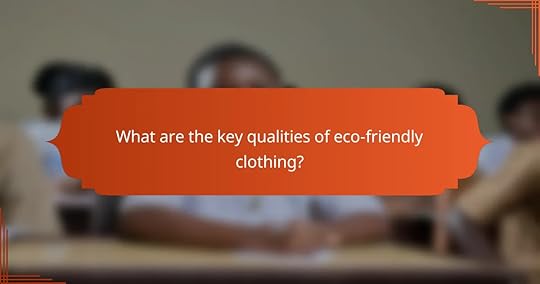
Eco-friendly clothing is characterized by its use of sustainable practices and materials that minimize environmental impact. Key qualities include organic materials, fair trade certification, low-impact dyes, and durability, all contributing to a more responsible fashion industry.
Organic materialsOrganic materials are grown without synthetic pesticides or fertilizers, promoting healthier ecosystems. Common organic fabrics include cotton, linen, and hemp, which are often certified by organizations like the Global Organic Textile Standard (GOTS).
When shopping, look for labels that specify organic certification to ensure the materials are genuinely eco-friendly. This not only supports sustainable agriculture but also reduces exposure to harmful chemicals.
Fair trade certificationFair trade certification ensures that workers involved in the production of clothing receive fair wages and work under safe conditions. This certification often includes environmental standards that promote sustainable practices.
Brands with fair trade certification typically invest in community development and environmental sustainability. When choosing clothing, prioritize brands that display fair trade labels to support ethical labor practices.
Low-impact dyesLow-impact dyes are used in the coloring process of fabrics to reduce water pollution and chemical runoff. These dyes are often derived from natural sources or are designed to have a minimal environmental footprint.
When selecting clothing, look for items labeled as dyed with low-impact or non-toxic dyes. This choice not only benefits the environment but also often results in softer, more vibrant colors.
Durability and longevityDurability and longevity refer to the lifespan of clothing items, emphasizing the importance of quality over quantity. Eco-friendly clothing is designed to withstand wear and tear, reducing the need for frequent replacements.
Investing in high-quality, durable pieces can save money in the long run and decrease waste. Check for reinforced seams and high-quality materials to ensure your clothing lasts longer, contributing to a more sustainable wardrobe.
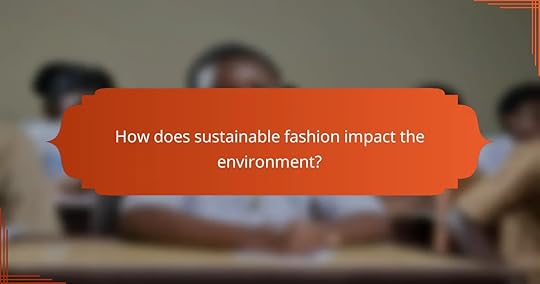
Sustainable fashion significantly reduces negative environmental effects by promoting eco-friendly practices in clothing production and consumption. This approach minimizes waste, lowers carbon emissions, and conserves vital resources, contributing to a healthier planet.
Reduces waste in landfillsSustainable fashion focuses on reducing textile waste, which is a major contributor to landfill overflow. By choosing high-quality, durable clothing and supporting brands that prioritize recycling and upcycling, consumers can help divert millions of tons of fabric from landfills each year.
Additionally, many sustainable brands offer take-back programs, allowing customers to return old garments for recycling or repurposing. This circular approach not only reduces waste but also encourages responsible consumption habits.
Lowers carbon footprintThe production of conventional clothing is a significant source of greenhouse gas emissions. Sustainable fashion aims to lower this carbon footprint by utilizing eco-friendly materials and energy-efficient manufacturing processes. For instance, organic cotton production typically emits less carbon compared to conventional cotton.
Consumers can further reduce their carbon impact by opting for second-hand clothing or brands that prioritize local production, which minimizes transportation emissions. Supporting companies that are transparent about their supply chains also fosters a more sustainable industry.
Conserves water resourcesWater consumption in the fashion industry is staggering, with conventional textile production requiring vast amounts of water for growing crops and processing fabrics. Sustainable fashion seeks to conserve water by promoting the use of organic materials and innovative techniques that reduce water usage.
For example, brands that utilize waterless dyeing technologies or recycled materials can significantly cut down on water consumption. Consumers can contribute by choosing clothing made from sustainable fibers, such as Tencel or hemp, which generally require less water to produce.
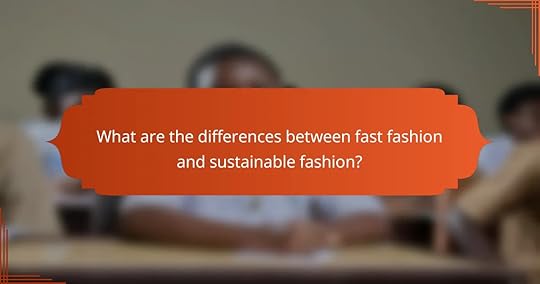
Fast fashion prioritizes rapid production and low costs, often at the expense of quality and ethical practices. In contrast, sustainable fashion focuses on long-lasting quality, eco-friendly materials, and fair labor conditions.
Production speedFast fashion brands produce clothing at an incredibly rapid pace, often releasing new collections weekly. This speed allows them to quickly respond to trends but sacrifices quality and durability in the process.
Sustainable fashion, on the other hand, takes a slower approach, emphasizing thoughtful design and production. This can mean longer lead times, but the result is typically higher-quality garments that last longer.
Environmental impactFast fashion has a significant negative impact on the environment, contributing to pollution, waste, and resource depletion. The industry is known for using harmful chemicals and generating vast amounts of textile waste.
Sustainable fashion aims to minimize environmental harm by using eco-friendly materials, reducing waste, and implementing sustainable practices throughout the supply chain. For example, brands may use organic cotton or recycled fabrics to lessen their ecological footprint.
Labor practicesFast fashion often relies on low-cost labor in developing countries, where workers may face poor working conditions and low wages. This model prioritizes profit over the well-being of employees.
Sustainable fashion emphasizes fair labor practices, ensuring that workers are paid a living wage and work in safe conditions. Many sustainable brands are transparent about their supply chains and actively support ethical labor initiatives.
November 18, 2025
Upcycled Fashion: Popularity, Benefits and Young Consumers
Upcycled fashion is rapidly becoming popular among young consumers, merging sustainability with personal expression and affordability. This innovative approach not only reduces waste but also supports local artisans and fosters creativity, making it a compelling choice for those who value both style and environmental responsibility.

Upcycled fashion is gaining traction among young consumers due to its blend of sustainability, individuality, and affordability. This trend allows individuals to express their unique style while contributing positively to the environment.
Environmental awarenessYoung consumers are increasingly concerned about the environmental impact of fast fashion, which contributes significantly to waste and pollution. Upcycled fashion offers a solution by repurposing existing materials, thereby reducing the need for new resources and minimizing landfill contributions.
Many young people are motivated by the desire to support sustainable practices. By choosing upcycled clothing, they feel they are making a positive impact on the planet, aligning their purchasing choices with their values.
Unique style expressionUpcycled fashion allows young consumers to showcase their individuality through one-of-a-kind pieces. Each item is often distinct, reflecting personal creativity and style, which is appealing in a world dominated by mass-produced clothing.
By wearing upcycled garments, individuals can stand out from the crowd and avoid the cookie-cutter looks often found in mainstream fashion. This uniqueness fosters a sense of identity and personal expression.
AffordabilityUpcycled fashion can be more affordable than traditional retail options, making it accessible for young consumers, especially students or those on a budget. Thrifted or repurposed items often come at a lower price point compared to new, branded clothing.
Additionally, many young people are turning to DIY upcycling projects, which can be a cost-effective way to refresh their wardrobe. Simple alterations or creative repurposing can transform inexpensive items into fashionable pieces.
Social media influenceSocial media platforms play a significant role in promoting upcycled fashion among young consumers. Influencers and brands showcase unique upcycled pieces, creating trends and inspiring followers to embrace sustainable fashion choices.
Platforms like Instagram and TikTok provide a space for users to share their upcycled creations, further fueling interest and engagement. This visibility encourages others to explore upcycled options, contributing to the growing popularity of this fashion movement.

Upcycled fashion offers numerous benefits, including waste reduction, support for local artisans, and a commitment to sustainability. By transforming discarded materials into new clothing, it not only minimizes environmental impact but also fosters creativity and community engagement.
Reduces wasteUpcycled fashion significantly reduces waste by repurposing materials that would otherwise end up in landfills. This process involves creatively using leftover fabrics, old garments, or other discarded items to create new products, thus extending their lifecycle.
For example, a single upcycled garment can prevent several kilograms of textile waste from being discarded. Consumers can contribute by choosing brands that prioritize upcycling or by creating their own upcycled pieces at home.
Supports local artisansUpcycled fashion often involves local artisans who bring unique skills and craftsmanship to the process. By purchasing upcycled items, consumers directly support these creators and contribute to their livelihoods.
This support helps sustain local economies and fosters a sense of community. Many upcycled brands collaborate with artisans to create exclusive collections, enhancing the value of each piece while promoting traditional techniques.
Promotes sustainabilityUpcycled fashion promotes sustainability by reducing the demand for new materials and the resources required for their production. This approach lessens the environmental footprint associated with traditional fashion manufacturing, which can be resource-intensive.
Additionally, upcycling encourages consumers to think critically about their purchasing habits and the lifecycle of their clothing. Choosing upcycled options can lead to a more sustainable wardrobe, aligning with broader environmental goals and reducing overall consumption.
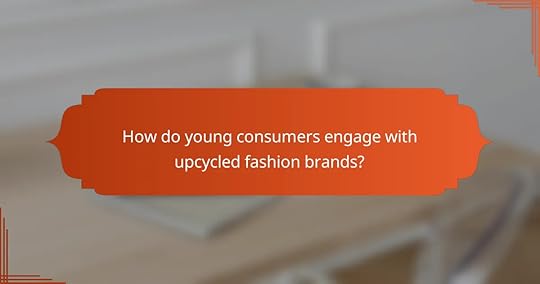
Young consumers actively engage with upcycled fashion brands through various channels, including online shopping platforms, social media, and community events. Their interest is driven by a desire for sustainable practices and unique fashion choices that reflect their values.
Online shopping platformsOnline shopping platforms play a crucial role in how young consumers discover and purchase upcycled fashion. Websites like Etsy and Depop allow users to browse a wide range of unique, upcycled items, often from independent sellers. This accessibility encourages young shoppers to explore sustainable options without the constraints of traditional retail.
Many upcycled fashion brands also have their own e-commerce sites, providing a direct connection to consumers. This approach allows brands to share their stories and sustainability practices, which resonate with environmentally conscious shoppers.
Social media campaignsSocial media campaigns are vital for promoting upcycled fashion among young consumers. Platforms like Instagram and TikTok enable brands to showcase their products through visually appealing content, often featuring influencers who embody the sustainable lifestyle. Engaging content, such as styling tips or behind-the-scenes looks at the upcycling process, helps to build a community around the brand.
Hashtags related to upcycled fashion, such as #UpcycledFashion or #SustainableStyle, allow users to find and share their favorite pieces, further amplifying brand visibility. This organic sharing fosters a sense of belonging and encourages young consumers to participate in sustainable fashion movements.
Community eventsCommunity events provide young consumers with hands-on experiences related to upcycled fashion. Workshops, swap meets, and local markets allow individuals to learn about upcycling techniques and connect with like-minded peers. These events often emphasize the importance of sustainability and creativity in fashion.
Participating in community events can also strengthen brand loyalty, as consumers feel a personal connection to the brands they support. Local initiatives that promote upcycled fashion can inspire young shoppers to make more conscious choices and advocate for sustainable practices within their communities.

Consumers should evaluate the quality of materials and brand transparency when selecting upcycled fashion. These factors significantly influence the durability, sustainability, and ethical implications of their purchases.
Quality of materialsThe quality of materials used in upcycled fashion is crucial for ensuring longevity and wearability. Look for items made from durable fabrics like denim, wool, or high-quality cotton, as these tend to withstand the test of time better than lesser materials.
Check for signs of wear or damage in upcycled pieces. A well-constructed item may have been repaired or altered, but it should still feel sturdy and reliable. If possible, inquire about the original source of the materials to understand their previous use and condition.
Brand transparencyBrand transparency is essential in upcycled fashion, as it reflects the company’s commitment to sustainability and ethical practices. Consumers should seek brands that openly share information about their sourcing, production processes, and the environmental impact of their products.
Look for certifications or labels that indicate adherence to sustainable practices. Brands that provide clear details about their upcycling methods and the origins of their materials often foster greater trust and accountability. Engaging with brands through social media or their websites can also reveal their values and practices.
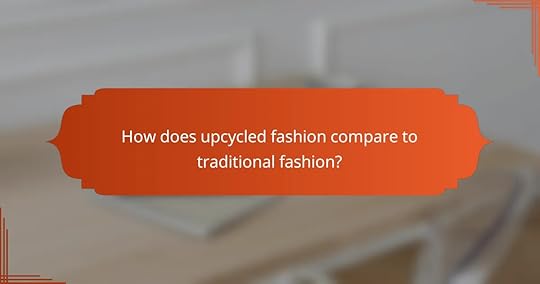
Upcycled fashion involves transforming old or discarded materials into new clothing, contrasting with traditional fashion that typically relies on new resources. This innovative approach not only reduces waste but also offers unique styles that appeal to environmentally conscious consumers.
Environmental impactUpcycled fashion significantly reduces the environmental footprint compared to traditional fashion. By reusing materials, it minimizes waste in landfills and decreases the demand for new textiles, which often require extensive water and energy resources to produce.
In addition, upcycling helps lower carbon emissions associated with manufacturing processes. For example, creating a single t-shirt from recycled materials can save several liters of water and reduce greenhouse gas emissions compared to producing one from virgin cotton.
Cost-effectivenessUpcycled fashion can be more cost-effective for consumers, as it often features lower price points than new designer items. Shoppers can find unique pieces at thrift stores or online marketplaces, typically ranging from a few dollars to moderate prices depending on the brand and craftsmanship.
However, the cost-effectiveness can vary based on the quality of materials used and the labor involved in the upcycling process. Investing in well-made upcycled items may save money in the long run due to their durability.
Fashion trendsUpcycled fashion is increasingly becoming a trend among young consumers who value sustainability and individuality. Many brands are now incorporating upcycled materials into their collections, appealing to a market that prioritizes ethical consumption.
Moreover, social media platforms play a significant role in promoting upcycled fashion. Influencers and fashion enthusiasts showcase their unique upcycled outfits, encouraging others to embrace this sustainable approach and inspiring a broader movement within the fashion industry.
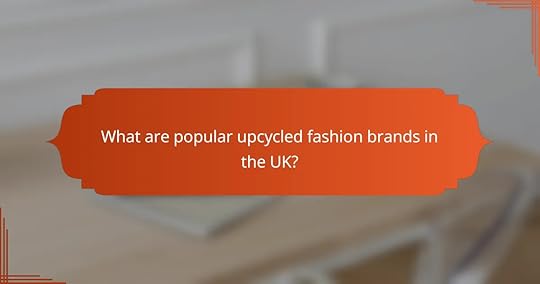
In the UK, several upcycled fashion brands have gained popularity for their commitment to sustainability and unique designs. These brands focus on repurposing materials to create stylish clothing while minimizing waste and environmental impact.
ReformationReformation is a leading upcycled fashion brand known for its trendy and eco-friendly apparel. The company emphasizes transparency in its production processes, using sustainable materials and practices to reduce its carbon footprint.
They offer a range of clothing, from dresses to activewear, often incorporating reclaimed fabrics into their designs. Shoppers can expect to find stylish options that not only look good but also contribute to a more sustainable fashion industry.
PatagoniaPatagonia is renowned for its commitment to environmental responsibility and has a strong focus on upcycled materials. The brand incorporates recycled fabrics into many of its outdoor clothing lines, promoting durability and sustainability.
In addition to upcycling, Patagonia encourages customers to repair and recycle their gear, offering a range of services to extend the life of their products. This approach not only helps reduce waste but also fosters a culture of conscious consumerism among its clientele.
Recycled Polyester: Environmental Impact, Durability and Cost
Recycled polyester is an eco-friendly alternative that significantly reduces environmental impact by repurposing plastic waste, thereby conserving resources and minimizing pollution. Known for its durability, this material is ideal for various applications, offering longevity that withstands everyday use. Additionally, recycled polyester is often more cost-effective than virgin polyester, appealing to both manufacturers and consumers while promoting sustainable practices.

Recycled polyester significantly reduces environmental harm by minimizing waste and conserving resources. By repurposing plastic bottles and other materials, it lessens the need for virgin polyester production, which is resource-intensive and polluting.
Reduced landfill wasteUsing recycled polyester helps divert plastic waste from landfills, where it can take hundreds of years to decompose. Each ton of recycled polyester can prevent approximately 2,000 plastic bottles from ending up in waste sites, contributing to a cleaner environment.
By choosing products made from recycled polyester, consumers actively participate in waste reduction efforts. This choice not only supports recycling initiatives but also encourages manufacturers to adopt sustainable practices.
Lower carbon emissionsRecycled polyester production generates significantly lower carbon emissions compared to virgin polyester. Estimates suggest that using recycled materials can reduce greenhouse gas emissions by around 30-50% during the manufacturing process.
This reduction is crucial in combating climate change, as the textile industry is a major contributor to global carbon emissions. By opting for recycled polyester, consumers can help lessen their carbon footprint and promote a more sustainable future.
Conservation of resourcesRecycled polyester conserves natural resources by reducing the need for petroleum, the primary raw material for virgin polyester. The recycling process requires less energy and water, making it a more efficient choice overall.
Additionally, using recycled materials helps to preserve ecosystems that might otherwise be damaged by resource extraction. This conservation is vital for maintaining biodiversity and ensuring the health of our planet for future generations.

Recycled polyester offers significant durability benefits, making it a popular choice for various applications. Its robust construction enhances longevity, allowing products made from this material to withstand daily wear and tear effectively.
High tensile strengthRecycled polyester exhibits high tensile strength, which means it can endure substantial pulling and stretching without breaking. This characteristic is crucial for items like outdoor gear and activewear, where durability is essential. Products made from recycled polyester can often last longer than those made from conventional materials.
Resistance to wear and tearOne of the standout features of recycled polyester is its resistance to wear and tear. This material can withstand friction and abrasion, making it ideal for clothing and accessories that experience frequent use. For instance, recycled polyester garments maintain their appearance and functionality even after numerous washes.
Moisture-wicking propertiesRecycled polyester is known for its moisture-wicking properties, which help keep the wearer dry by drawing sweat away from the skin. This feature is particularly beneficial in athletic apparel, where comfort during physical activity is paramount. By managing moisture effectively, recycled polyester enhances the overall durability of the fabric, as it reduces the risk of mildew and odor buildup.
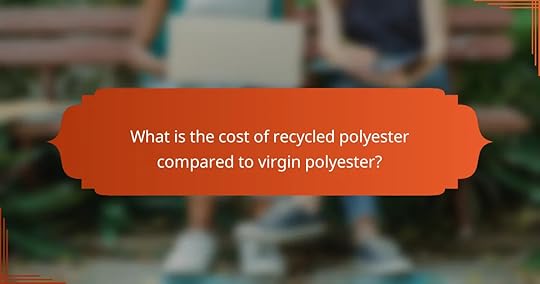
The cost of recycled polyester is generally lower than that of virgin polyester, making it an attractive option for manufacturers and consumers alike. However, prices can vary based on factors such as production scale, quality, and market demand.
Price per yard comparisonOn average, recycled polyester can cost about 10-30% less per yard than virgin polyester, depending on the supplier and specific material properties. This price difference is influenced by the availability of recycled materials and the technology used in processing them.
For example, a typical price range for recycled polyester might be around $3 to $5 per yard, while virgin polyester could range from $4 to $7 per yard. These figures can fluctuate based on market conditions and sourcing practices.
Long-term savings on replacementsChoosing recycled polyester can lead to long-term savings due to its durability and resistance to wear and tear. Products made from recycled polyester often have a longer lifespan, reducing the need for frequent replacements.
For instance, garments made from recycled polyester may last 20-30% longer than those made from virgin polyester, translating to fewer purchases over time. This durability can offset the initial cost difference, making recycled options more economical in the long run.
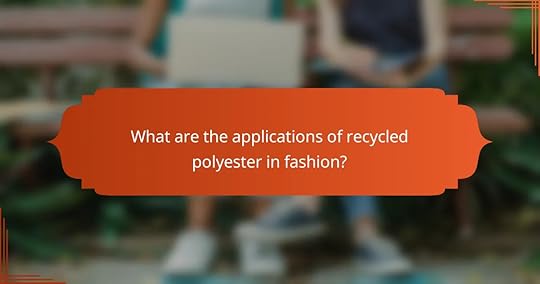
Recycled polyester is widely used in fashion for its versatility and sustainability. It is commonly found in various clothing items, from casual wear to high-performance activewear, making it a popular choice among brands aiming to reduce their environmental footprint.
Activewear productionRecycled polyester is particularly beneficial in activewear production due to its durability and moisture-wicking properties. It can withstand rigorous activities while providing comfort, making it ideal for sportswear. Many brands utilize this material to create leggings, sports bras, and jackets that perform well under stress.
When selecting activewear made from recycled polyester, look for items that feature a blend with other sustainable materials to enhance performance. Brands often highlight their use of this fabric, so check labels for recycled content percentages to ensure you’re making an eco-friendly choice.
Eco-friendly fashion brandsNumerous eco-friendly fashion brands incorporate recycled polyester into their collections, promoting sustainability without sacrificing style. These brands often focus on transparency, sharing information about their sourcing and manufacturing processes to build consumer trust.
Popular eco-conscious brands include Patagonia, Adidas, and Reformation, which offer a range of products made from recycled materials. When shopping, consider supporting these brands to contribute to a more sustainable fashion industry while enjoying high-quality apparel.
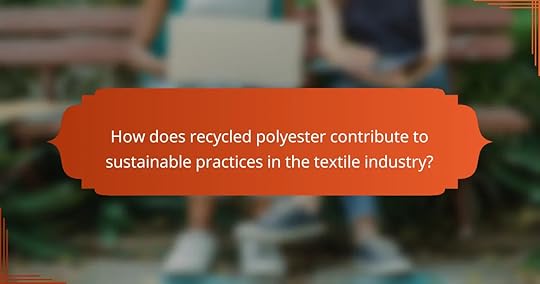
Recycled polyester plays a significant role in promoting sustainable practices within the textile industry by reducing waste and conserving resources. By repurposing plastic bottles and other materials, it minimizes the need for virgin polyester, thereby lowering energy consumption and greenhouse gas emissions during production.
Support for circular economyRecycled polyester supports the circular economy by keeping materials in use for longer periods and reducing landfill waste. This approach encourages manufacturers to design products that can be easily recycled at the end of their life cycle, fostering a system where resources are reused rather than discarded.
For example, brands that utilize recycled polyester often implement take-back programs, allowing consumers to return worn items for recycling. This not only promotes sustainability but also builds customer loyalty and enhances brand reputation.
Partnerships with recycling organizationsPartnerships with recycling organizations are crucial for the success of recycled polyester initiatives. These collaborations help ensure a steady supply of recycled materials and improve the efficiency of collection and processing systems.
Many textile companies work alongside NGOs and local governments to establish recycling programs that educate consumers on proper disposal methods. This collective effort not only increases the volume of recycled polyester available but also raises awareness about the importance of sustainable practices in the industry.
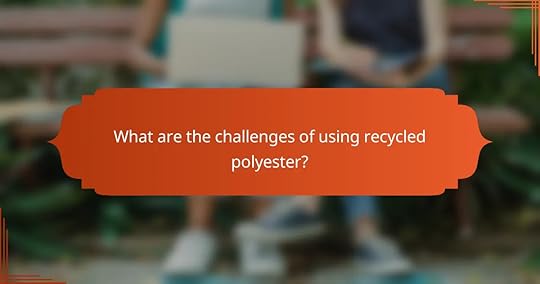
Recycled polyester presents several challenges, including quality variability and limited availability. These factors can affect the performance and cost-effectiveness of products made from this material.
Quality variabilityThe quality of recycled polyester can vary significantly based on the source materials and recycling processes used. For instance, polyester derived from post-consumer bottles may have different properties compared to that sourced from industrial waste. This inconsistency can lead to variations in durability, texture, and overall performance.
Manufacturers must carefully assess the quality of recycled polyester before use. It is advisable to work with trusted suppliers who adhere to recognized recycling standards, ensuring a more reliable product. Regular testing and quality control measures can help mitigate risks associated with quality variability.
Limited availabilityRecycled polyester is not always readily available, which can pose challenges for manufacturers seeking to incorporate it into their products. The supply chain for recycled materials can be less stable compared to virgin polyester, leading to potential shortages or delays. This limitation may affect production timelines and costs.
To address limited availability, businesses should consider building relationships with multiple suppliers and exploring local recycling initiatives. Engaging in collaborative efforts can help secure a more consistent supply of recycled polyester, ultimately supporting sustainability goals while minimizing disruptions in production.
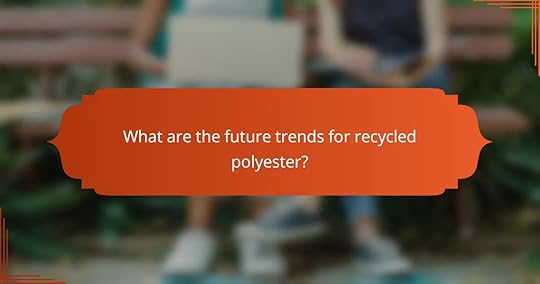
The future of recycled polyester is shaped by advancements in technology, growing consumer preferences for sustainable products, and the exploration of new markets. These trends indicate a significant shift towards more environmentally friendly practices in the textile industry.
Innovations in recycling technologyRecycling technology for polyester is rapidly evolving, with new methods that enhance the efficiency and quality of recycled materials. Techniques such as chemical recycling allow for the breakdown of polyester into its original monomers, enabling the production of high-quality fibers that can compete with virgin polyester.
Additionally, advancements in sorting and processing technologies improve the recovery rates of polyester from waste streams. This not only increases the availability of recycled polyester but also reduces the environmental footprint associated with its production.
Increased consumer demand for sustainabilityConsumers are increasingly prioritizing sustainability in their purchasing decisions, driving brands to adopt recycled polyester in their products. This shift is evident in the fashion industry, where many companies now feature recycled materials prominently in their collections.
Brands that embrace recycled polyester often highlight their commitment to environmental responsibility, which resonates with eco-conscious consumers. This trend is expected to continue, pushing more manufacturers to source sustainable materials to meet market demand.
Expansion into new marketsThe market for recycled polyester is expanding beyond traditional clothing and textiles into sectors such as automotive and home furnishings. This diversification opens new opportunities for recycled polyester applications, increasing its overall market share.
As industries recognize the benefits of using recycled materials, partnerships between textile manufacturers and other sectors are likely to grow. This collaboration can lead to innovative products that utilize recycled polyester, further promoting sustainability across various markets.
Technology in Sustainable Fashion: Innovations, Tools and Impact
Technology is playing a pivotal role in transforming the sustainable fashion landscape, with innovations aimed at minimizing environmental impact through advanced materials and production techniques. From 3D printing to biodegradable fabrics and smart textiles, these developments are enabling brands to enhance resource efficiency and promote eco-friendly practices in the apparel industry.

The latest innovations in sustainable fashion technology focus on reducing environmental impact through advanced materials and production methods. Key developments include 3D printing, biodegradable materials, and smart textiles, each contributing to a more eco-friendly apparel industry.
3D printing for eco-friendly apparel3D printing allows for the creation of garments with minimal waste, as items are produced layer by layer directly from digital designs. This technology reduces the need for traditional cutting and sewing processes, which often generate excess fabric scraps.
Brands are increasingly adopting 3D printing to customize clothing, enabling on-demand production that aligns with consumer preferences. This approach not only decreases inventory costs but also minimizes overproduction, a significant issue in the fashion industry.
Biodegradable materials in clothingBiodegradable materials are designed to break down naturally over time, reducing landfill waste associated with traditional textiles. Innovations include fabrics made from organic cotton, hemp, and new synthetic fibers that decompose within a few years instead of decades.
When selecting biodegradable clothing, consumers should look for certifications that ensure the materials meet environmental standards. Brands that prioritize these materials often highlight their sustainability efforts, making it easier for eco-conscious shoppers to make informed choices.
Smart textiles for waste reductionSmart textiles incorporate technology that can monitor and adapt to environmental conditions, enhancing garment longevity and functionality. These textiles can reduce waste by providing real-time data on wear and tear, helping consumers make better decisions about when to repair or recycle items.
Examples include fabrics that change color with temperature or moisture levels, indicating when a garment needs washing. By extending the life of clothing and minimizing unnecessary laundry, smart textiles contribute to a more sustainable fashion ecosystem.

Brands are increasingly adopting sustainable fashion technologies to reduce their environmental impact and enhance resource efficiency. These innovations often focus on materials, production processes, and supply chain transparency.
Patagonia’s recycled materials initiativePatagonia has pioneered the use of recycled materials in its products, significantly reducing waste and resource consumption. The company sources materials like recycled polyester from plastic bottles and discarded fishing nets, which helps divert waste from landfills.
This initiative not only lowers the carbon footprint associated with raw material extraction but also promotes a circular economy. Consumers can contribute by choosing products made from recycled materials, thereby supporting sustainability in fashion.
Adidas’ Parley for the Oceans collaborationAdidas collaborates with Parley for the Oceans to create footwear and apparel made from ocean plastic waste. This partnership transforms plastic debris collected from coastlines into high-performance materials, addressing both pollution and resource scarcity.
The resulting products, such as the UltraBOOST Parley shoes, highlight the potential for innovation in sustainable fashion. Customers are encouraged to participate in beach clean-ups and support brands that prioritize environmental responsibility, reinforcing the message of sustainability.

Several innovative tools are available for sustainable fashion design, enabling designers to create eco-friendly garments efficiently. These tools focus on reducing waste, optimizing resources, and enhancing the overall design process.
Adobe Illustrator for sustainable fashionAdobe Illustrator is a powerful design tool widely used in the fashion industry, allowing designers to create detailed garment sketches and technical specifications. Its vector-based graphics enable precise manipulation of design elements, which helps minimize fabric waste during production.
Designers can utilize features like pattern making and color separation to streamline their workflow. By using Illustrator’s templates and libraries, they can also ensure consistency and reduce the time spent on repetitive tasks, ultimately leading to more sustainable practices.
Optitex for virtual prototypingOptitex is a leading software for virtual prototyping that allows designers to create 3D garment simulations. This tool helps visualize how fabrics will behave in real life, enabling designers to make informed decisions before physical samples are produced, thus reducing material waste.
With Optitex, users can test different fabric types, colors, and patterns in a virtual environment. This capability not only speeds up the design process but also supports sustainable practices by minimizing the number of physical prototypes needed, saving both time and resources.
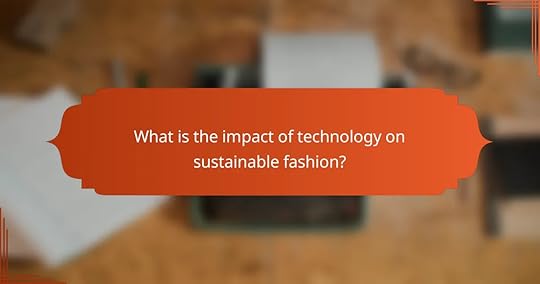
Technology significantly enhances sustainable fashion by enabling eco-friendly practices and reducing waste. Innovations such as digital design tools, sustainable materials, and data analytics help brands minimize their environmental impact while meeting consumer demand for transparency and ethical production.
Reduction of carbon footprintTechnological advancements play a crucial role in reducing the carbon footprint of the fashion industry. For instance, using 3D printing can minimize material waste, while digital prototyping reduces the need for physical samples, leading to lower emissions throughout the production process.
Additionally, renewable energy sources, such as solar and wind, are increasingly being adopted in manufacturing facilities. Brands that invest in these technologies can significantly lower their greenhouse gas emissions, contributing to a more sustainable future.
Improved supply chain transparencyTechnology enhances supply chain transparency by utilizing blockchain and data tracking systems. These tools allow brands and consumers to trace the origins of materials, ensuring ethical sourcing and production practices. This transparency builds trust and encourages responsible consumer behavior.
Moreover, digital platforms can facilitate real-time monitoring of supply chain activities, helping brands quickly identify and address sustainability issues. Implementing these technologies not only improves compliance with regulations but also aligns with growing consumer expectations for ethical practices in fashion.
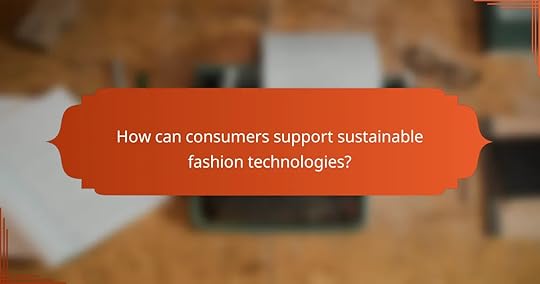
Consumers can support sustainable fashion technologies by making informed choices about the brands they purchase from and actively participating in recycling initiatives. These actions help promote eco-friendly practices and reduce waste in the fashion industry.
Choosing brands with eco-friendly practicesSelecting brands that prioritize eco-friendly practices is essential for supporting sustainable fashion. Look for companies that use organic materials, implement fair labor practices, and have transparent supply chains. Many brands now provide information about their sustainability efforts on their websites or product labels.
Consider supporting brands that are certified by recognized standards such as Global Organic Textile Standard (GOTS) or Fair Trade. These certifications indicate a commitment to environmental and social responsibility. Additionally, explore local brands that focus on sustainable production methods, as they often have a smaller carbon footprint.
Participating in clothing recycling programsEngaging in clothing recycling programs is a practical way to contribute to sustainable fashion. Many retailers offer take-back programs where consumers can return old garments for recycling or repurposing. This not only reduces landfill waste but also encourages the circular economy.
Research local initiatives that accept clothing donations or recycling. Some organizations even provide incentives, such as discounts on future purchases, for participating in these programs. Always check the condition of the items you���re recycling, as many programs have specific guidelines on what can be accepted.
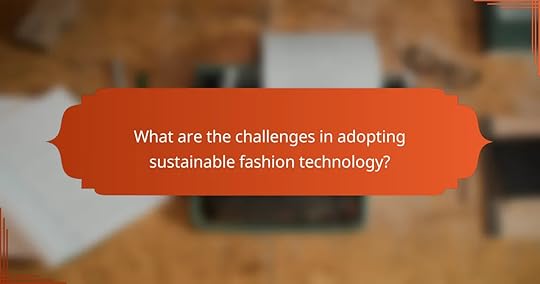
Adopting sustainable fashion technology faces several challenges, including high costs and a lack of consumer awareness. These obstacles can hinder the widespread implementation of innovative solutions that promote environmental responsibility in the fashion industry.
High costs of innovative materialsThe high costs associated with innovative sustainable materials often deter brands from adopting them. For instance, bio-based fabrics and recycled textiles can be significantly more expensive than conventional materials, impacting overall production budgets.
Brands must weigh the long-term benefits of investing in sustainable materials against the initial financial outlay. While prices may range from 20% to 50% higher for eco-friendly options, the potential for brand loyalty and market differentiation can justify the investment.
Lack of consumer awarenessA lack of consumer awareness about sustainable fashion technology poses a significant barrier to its adoption. Many consumers are not familiar with the benefits of eco-friendly materials or the impact of their purchasing decisions on the environment.
Brands can address this challenge by educating their customers through marketing campaigns, social media, and in-store experiences. Providing clear information about the sustainability of products can help consumers make informed choices, ultimately driving demand for innovative solutions in the fashion industry.
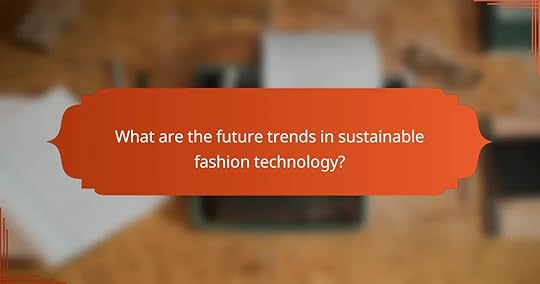
Future trends in sustainable fashion technology focus on innovative solutions that reduce environmental impact and enhance resource efficiency. Key developments include the integration of artificial intelligence and the rise of circular fashion models, both of which aim to create a more sustainable industry.
Integration of AI in sustainable sourcingArtificial intelligence is transforming sustainable sourcing by optimizing supply chains and reducing waste. AI algorithms can analyze vast amounts of data to identify the most sustainable materials and suppliers, ensuring that brands make informed decisions that align with their sustainability goals.
For example, AI can predict demand more accurately, helping brands avoid overproduction and excess inventory. This not only minimizes waste but also reduces costs associated with unsold products. Companies should consider investing in AI tools that provide insights into sustainable sourcing practices.
Growth of circular fashion modelsCircular fashion models emphasize the reuse and recycling of materials to extend the lifecycle of products. This approach encourages brands to design items that can be easily repaired, refurbished, or recycled, thus reducing the overall environmental footprint of fashion.
Brands adopting circular models often implement take-back programs, allowing consumers to return used items for recycling or resale. This not only fosters customer loyalty but also contributes to a more sustainable economy. Companies should explore partnerships with recycling facilities and invest in technologies that support circularity in their production processes.
Sustainable Brands: Choosing Based on Personal Values
Choosing sustainable brands that align with your personal values is essential for making purchases that reflect your beliefs and contribute to a more sustainable future. By identifying what matters most to you and researching how brands operate, you can support companies that prioritize environmental responsibility and ethical practices. This conscious consumerism not only benefits the planet but also promotes a culture of responsible consumption.

Choosing sustainable brands that resonate with your personal values involves identifying what matters most to you and researching how brands align with those principles. This process ensures that your purchases reflect your beliefs, contributing to a more sustainable future.
Identify core personal valuesStart by reflecting on your core personal values, such as environmental responsibility, social justice, or ethical labor practices. Consider what issues resonate most with you and how they influence your purchasing decisions.
Make a list of your top values and rank them. This will help you prioritize which aspects of sustainability are most important when evaluating brands.
Research brand sustainability practicesInvestigate the sustainability practices of brands you are considering. Look for certifications like Fair Trade, Organic, or B Corp, which indicate a commitment to ethical practices and environmental stewardship.
Read reviews and reports from reputable sources that assess brand sustainability. Websites like Good On You provide insights into how brands perform in terms of environmental impact and labor practices.
Evaluate product lifecycle impactsAssess the entire lifecycle of products, from sourcing materials to manufacturing, distribution, and disposal. Consider how a brand minimizes waste and reduces carbon emissions throughout this process.
Look for brands that use sustainable materials and have transparent supply chains. Brands that offer take-back programs or recycling options can also demonstrate a commitment to reducing their environmental footprint.
Consider community engagement initiativesExamine how brands engage with their communities and support social causes. Brands that invest in local communities or contribute to social initiatives often align better with personal values centered on social responsibility.
Check if the brand partners with local organizations or supports fair wages for workers. This can indicate a genuine commitment to making a positive impact beyond just selling products.
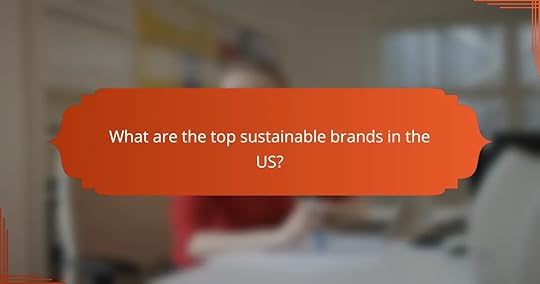
The top sustainable brands in the US prioritize environmental responsibility and ethical practices in their operations. Brands like Patagonia, Allbirds, and Seventh Generation exemplify how companies can align their products with sustainability principles, appealing to consumers who value eco-friendly choices.
Patagonia’s environmental commitmentPatagonia is renowned for its strong commitment to environmental sustainability, focusing on reducing its carbon footprint and promoting fair labor practices. The company uses recycled materials in its products and donates a percentage of its profits to environmental causes, making it a leader in corporate responsibility.
Consumers can support Patagonia by choosing their durable outdoor gear, which is designed to last and reduce waste. The brand also encourages customers to repair and recycle their products, further emphasizing its commitment to sustainability.
Allbirds’ eco-friendly materialsAllbirds is celebrated for its use of natural, sustainable materials such as merino wool and eucalyptus tree fibers in its footwear. This focus on eco-friendly materials helps minimize environmental impact while providing comfort and style.
When selecting shoes, consumers can consider Allbirds for their low carbon footprint and commitment to transparency in sourcing. The brand also offers a carbon offset program, allowing customers to contribute to environmental projects that counterbalance emissions from production.
Seventh Generation’s ethical productsSeventh Generation specializes in household and personal care products that are made with plant-based ingredients and are free from harmful chemicals. The brand emphasizes transparency in its labeling and strives for sustainability in its packaging and production processes.
Shoppers can choose Seventh Generation for their cleaning supplies and personal care items, knowing they are supporting a brand that prioritizes ethical sourcing and environmental stewardship. The company also advocates for policy changes that promote sustainability, further aligning with consumer values in the eco-conscious market.

Sustainable brands significantly reduce their environmental impact through practices that minimize waste, lower emissions, and conserve resources. By prioritizing eco-friendly materials and processes, these brands contribute to a healthier planet and promote responsible consumption.
Reduction of carbon footprintSustainable brands often focus on reducing their carbon footprint by utilizing renewable energy sources and optimizing their supply chains. For example, companies may invest in solar or wind energy to power their operations, which can lead to a reduction in greenhouse gas emissions by a substantial percentage.
Additionally, many sustainable brands implement strategies such as carbon offsetting, where they invest in projects that absorb carbon dioxide, like reforestation. Consumers can look for certifications or labels that indicate a brand’s commitment to carbon neutrality.
Conservation of natural resourcesConserving natural resources is a core principle of sustainable brands, which often use recycled or sustainably sourced materials in their products. This approach helps to minimize the depletion of finite resources, such as fossil fuels and water, which are critical for both production and ecosystem health.
For instance, brands that utilize organic cotton or recycled plastics can significantly reduce water usage and pollution associated with traditional manufacturing processes. Consumers should consider brands that provide transparency about their sourcing practices and resource management.
Promotion of ethical labor practicesSustainable brands typically prioritize ethical labor practices, ensuring fair wages and safe working conditions for their employees. By adhering to labor standards and certifications, these brands contribute to social sustainability alongside environmental efforts.
Many sustainable companies engage in fair trade practices, which support local communities and promote equitable trade relationships. Consumers can support these brands by looking for certifications like Fair Trade or B Corp, which signify a commitment to ethical labor practices.

To evaluate sustainable brands, consider factors such as transparency in sourcing, certifications and eco-labels, and community and social responsibility. These criteria help determine a brand’s commitment to sustainability and ethical practices.
Transparency in sourcingTransparency in sourcing involves understanding where and how a brand obtains its materials. Look for brands that openly share information about their supply chains and the origins of their products. This can include details on sourcing practices, labor conditions, and environmental impact.
Brands that prioritize transparency often provide traceability information, allowing consumers to verify claims. For instance, a clothing brand might disclose the farms where its cotton is grown or the factories where its garments are produced.
Certifications and eco-labelsCertifications and eco-labels serve as indicators of a brand’s sustainability efforts. Look for recognized certifications such as Fair Trade, USDA Organic, or Global Organic Textile Standard (GOTS). These labels signify that a brand meets specific environmental and social criteria.
While certifications can enhance credibility, not all labels are created equal. Research the standards behind each certification to ensure they align with your values. A brand with multiple reputable certifications may demonstrate a stronger commitment to sustainability.
Community and social responsibilityCommunity and social responsibility reflect a brand’s impact on society and its commitment to ethical practices. Evaluate how a brand supports local communities, engages in fair labor practices, and contributes to social causes. Brands that invest in their communities often have a more profound commitment to sustainability.
For example, a brand may partner with local artisans, provide fair wages, or engage in charitable initiatives. Assessing these aspects can help you choose brands that align with your personal values and contribute positively to society.

Supporting sustainable brands through e-commerce involves choosing retailers that prioritize eco-friendly practices and products. By making informed purchasing decisions, you can contribute to a more sustainable economy while aligning your shopping habits with your personal values.
Shop from certified online retailersWhen shopping online, look for retailers that have sustainability certifications, such as Fair Trade, B Corp, or USDA Organic. These certifications indicate that the brands adhere to specific environmental and social standards, ensuring that your purchases support responsible practices.
Additionally, many online platforms now feature filters for sustainable products. Utilize these tools to easily find eco-friendly options, and consider checking customer reviews to gauge the brand’s commitment to sustainability.
Participate in brand loyalty programsJoining loyalty programs offered by sustainable brands can enhance your shopping experience while promoting eco-friendly practices. Many of these programs reward customers with points for purchases, which can be redeemed for discounts or exclusive products, encouraging repeat business.
Furthermore, some loyalty programs include initiatives like tree planting or donations to environmental causes for every purchase made. Engaging with these programs not only benefits you but also supports the brands’ sustainability efforts, creating a positive impact on the environment.
Upcycling Clothes: Creativity, Sustainability and Fashion Statements
Upcycling clothes is a vibrant movement that combines creativity with sustainability, allowing individuals to transform old garments into fashionable new pieces. This innovative practice not only reduces waste in the fashion industry but also empowers consumers to express their unique style while promoting eco-conscious habits. By exploring various techniques and sources of inspiration, anyone can embark on a journey to create stunning, personalized fashion statements from what might otherwise be discarded.
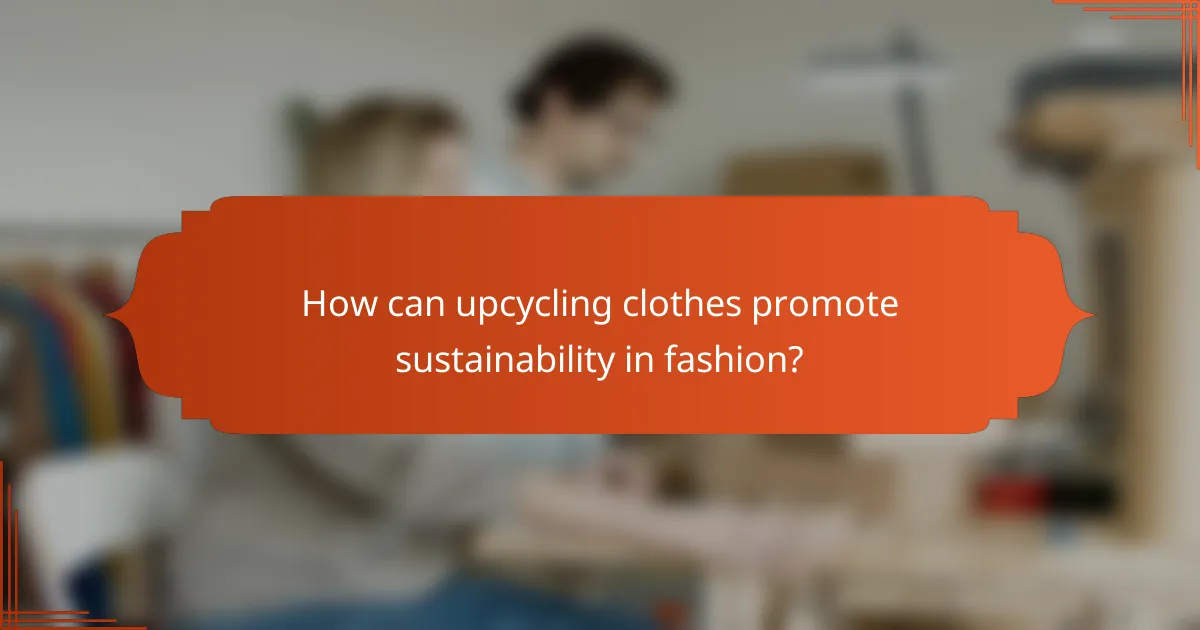
Upcycling clothes promotes sustainability in fashion by transforming old garments into new, stylish pieces, thereby reducing waste and conserving resources. This creative approach not only minimizes the environmental impact of the fashion industry but also encourages consumers to adopt more eco-conscious habits.
Reduces textile wasteUpcycling significantly reduces textile waste by repurposing items that would otherwise end up in landfills. The fashion industry is responsible for a large portion of global waste, with millions of tons of textiles discarded each year. By creatively reusing these materials, individuals can help divert waste from landfills and contribute to a more sustainable future.
For example, turning an old pair of jeans into a stylish tote bag not only gives the fabric a new life but also prevents it from contributing to the growing textile waste problem. This practice encourages a shift in mindset towards valuing existing materials rather than constantly seeking new ones.
Conserves resourcesUpcycling clothes conserves valuable resources by reducing the demand for new materials. The production of textiles often requires significant amounts of water, energy, and raw materials, contributing to environmental degradation. By upcycling, consumers can minimize the need for these resources and lessen the overall environmental footprint of their wardrobe.
For instance, creating a new garment from old fabric eliminates the need for new production processes, which can be resource-intensive. This not only saves water and energy but also reduces pollution associated with manufacturing new textiles.
Encourages eco-friendly practicesUpcycling encourages eco-friendly practices by promoting creativity and resourcefulness in fashion. It inspires individuals to think critically about their consumption habits and consider the environmental impact of their choices. By engaging in upcycling, consumers can develop a deeper appreciation for sustainability and its importance in the fashion industry.
Additionally, upcycling can foster community engagement through workshops and events where people share skills and ideas. This collaborative approach not only strengthens social bonds but also amplifies the message of sustainability, encouraging more people to adopt eco-friendly practices in their daily lives.
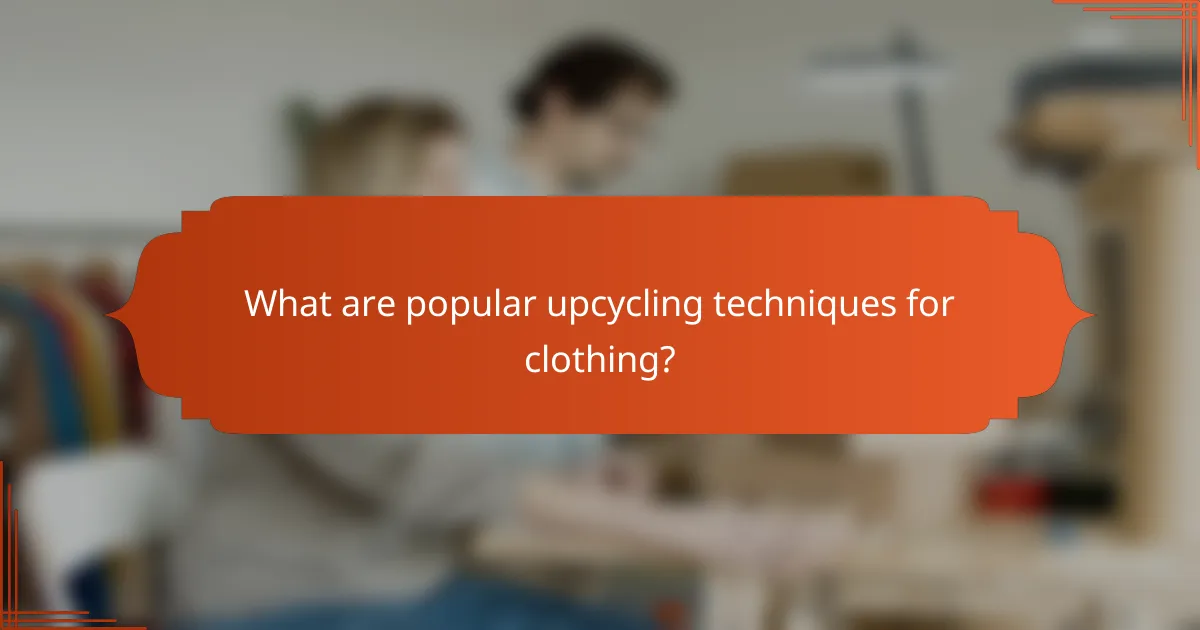
Popular upcycling techniques for clothing include methods that creatively repurpose old garments into new, stylish pieces. These techniques not only promote sustainability but also allow individuals to express their unique fashion sense.
Patchwork and embroideryPatchwork and embroidery are effective ways to breathe new life into worn-out clothing. By sewing together different fabric pieces, you can create a unique design that showcases your creativity. Embroidery can enhance these designs, adding intricate details and personal touches.
When considering patchwork, choose fabrics that complement each other in color and texture. This technique works well on jackets, bags, and even jeans. For embroidery, simple stitches can transform a plain garment into a statement piece.
Transforming old jeans into bagsTransforming old jeans into bags is a practical and stylish upcycling technique. This process involves cutting and sewing the jeans into various bag shapes, such as totes or crossbody styles. The durability of denim makes it an ideal material for bags.
To start, select a pair of jeans that you no longer wear. Cut the legs to your desired length and sew the openings to create a bag base. You can add pockets, straps, or embellishments to personalize your creation. This method not only reduces waste but also results in a functional accessory.
Reworking t-shirts into new stylesReworking t-shirts into new styles allows for endless creativity and customization. Techniques include cutting, tying, or adding fabric to create unique silhouettes. This approach is perfect for transforming oversized or outdated tees into trendy pieces.
For example, you can cut a t-shirt into a crop top or create a stylish off-the-shoulder look. Adding lace or other fabric can enhance the design further. This method is particularly appealing for those looking to refresh their wardrobe without spending money on new clothes.

Inspiration for upcycling projects can be found in various creative spaces, from social media to local workshops. Exploring these resources can ignite your imagination and help you transform old garments into fashionable statements.
Social media platforms like InstagramInstagram is a vibrant hub for upcycling inspiration, featuring countless creators who share their unique projects. By following hashtags such as #upcycle, #refashion, and #sustainablefashion, you can discover innovative ideas and techniques.
Engaging with the community through comments and direct messages can also provide valuable tips and encouragement. Consider saving posts that resonate with you to create a personal inspiration board.
DIY blogs and YouTube channelsMany DIY blogs and YouTube channels focus specifically on upcycling clothing, offering step-by-step guides and tutorials. These platforms often include detailed instructions, material lists, and videos that make the process accessible for beginners.
Look for channels that align with your style preferences and skill level. Bookmarking your favorite blogs can create a go-to resource for future projects, ensuring you have a wealth of ideas at your fingertips.
Upcycling workshops in urban areasParticipating in upcycling workshops can provide hands-on experience and direct guidance from experts. Many urban areas host classes that cater to various skill levels, allowing you to learn new techniques while meeting like-minded individuals.
Check local community centers, craft stores, or online platforms for upcoming workshops. These events often supply materials and tools, making it easier to dive into your projects without needing to invest heavily upfront.
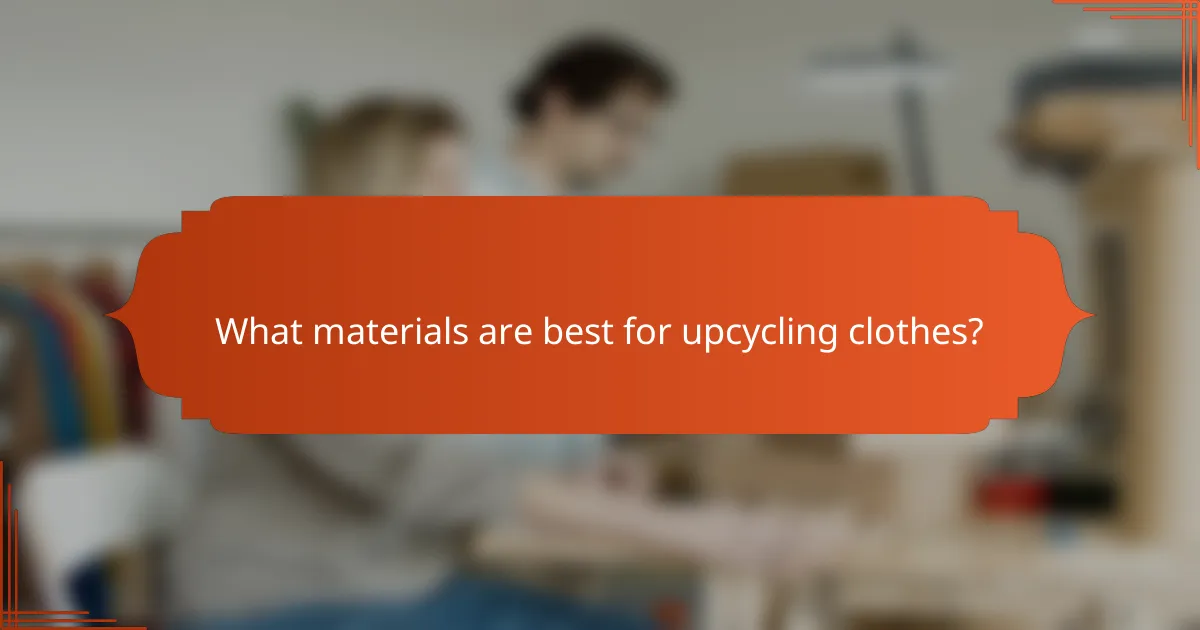
The best materials for upcycling clothes include natural fibers, denim, and vintage fabrics. These materials not only offer durability and versatility but also allow for creative expression while promoting sustainability.
Natural fibers like cotton and linenNatural fibers such as cotton and linen are excellent choices for upcycling due to their breathability and ease of manipulation. They can be easily dyed, sewn, or embroidered, making them ideal for various projects.
When selecting natural fibers, consider using pre-loved garments or remnants to minimize waste. Look for fabrics that are in good condition, as they will yield the best results in your upcycling endeavors.
Denim from old jeansDenim is a popular material for upcycling, particularly from old jeans. Its durability allows for a wide range of projects, from bags to jackets, and it can be easily combined with other fabrics.
When working with denim, consider the weight and color of the fabric. Heavier denim is suitable for structured items, while lighter denim can be used for more delicate applications. Don’t hesitate to mix different shades for a unique look.
Vintage fabrics from thrift storesVintage fabrics sourced from thrift stores are a treasure trove for upcycling enthusiasts. These materials often come in unique patterns and textures that can add character to any project.
When shopping for vintage fabrics, inspect them for wear and tear. Look for pieces that can be repurposed without compromising their integrity. A good rule of thumb is to choose fabrics that are at least 50% intact for successful upcycling.
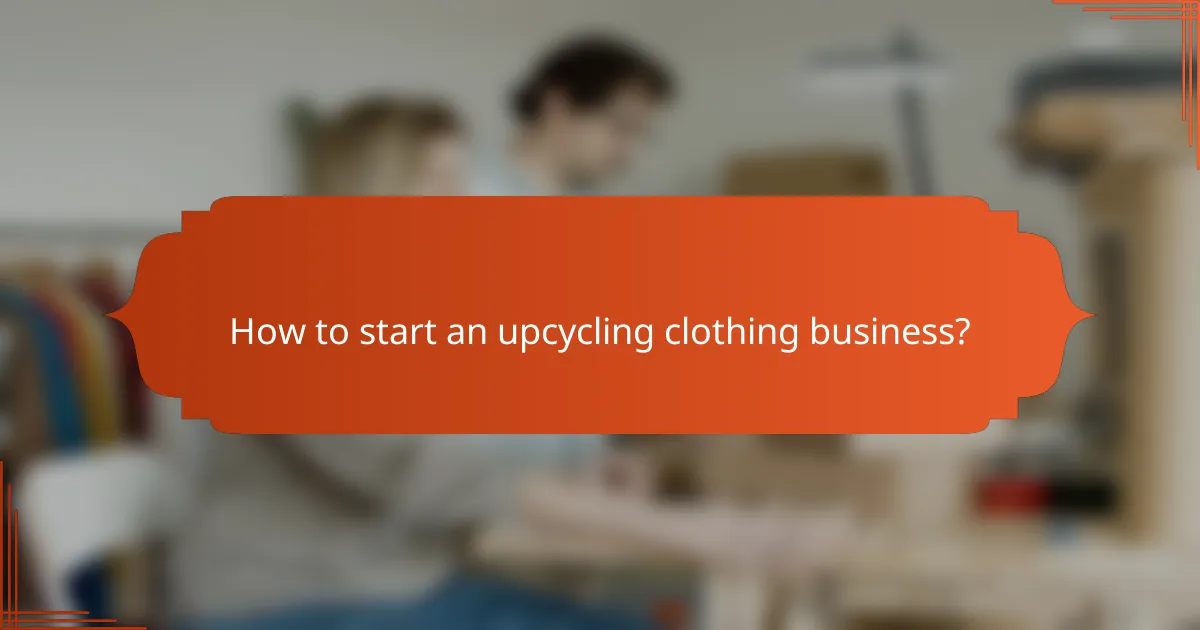
Starting an upcycling clothing business involves creatively transforming used garments into fashionable items while promoting sustainability. Focus on your design skills, sourcing materials, and understanding your audience to build a successful venture.
Identify your target marketUnderstanding your target market is crucial for your upcycling clothing business. Determine who is most likely to buy your products, such as eco-conscious consumers, fashion enthusiasts, or budget shoppers looking for unique pieces.
Consider demographics like age, gender, and lifestyle. For instance, younger consumers may prefer trendy, bold designs, while older customers might appreciate classic styles. Conduct surveys or social media polls to gather insights about potential customers��� preferences.
Source sustainable materialsSourcing sustainable materials is key to maintaining the eco-friendly ethos of your upcycling clothing business. Look for second-hand clothing, fabric remnants, or even thrift store finds that can be transformed into new designs.
Consider local sources to reduce your carbon footprint. Check community groups or online marketplaces for fabric donations or sales. Establish relationships with local thrift shops or textile recycling centers to ensure a steady supply of materials.
Set up an online store on platforms like EtsyCreating an online store on platforms like Etsy allows you to reach a wider audience for your upcycled clothing. Start by setting up an account, then create appealing listings with high-quality images and detailed descriptions of your items.
Utilize SEO strategies by including relevant keywords in your product titles and descriptions to improve visibility. Engage with customers through social media and encourage reviews to build credibility. Consider offering promotions or discounts to attract initial buyers and grow your customer base.
November 17, 2025
Eco-Friendly Fashion: Plus-Size Options, Style Tips and Comfort
Eco-friendly fashion is making strides in the plus-size market, offering stylish and sustainable options that cater to diverse tastes. By choosing materials like organic cotton and Tencel, you can enjoy comfort and style while minimizing your environmental footprint. Embrace versatile pieces that flatter your shape and allow for creative outfit combinations, ensuring you look good while being kind to the planet.

Eco-friendly plus-size fashion can be found through various channels, including online retailers, local boutiques, and specialty brands. These options cater to diverse styles while prioritizing sustainable practices.
Online retailers like ASOS and ModClothOnline retailers such as ASOS and ModCloth offer a wide range of eco-friendly plus-size clothing. They feature collections made from sustainable materials and often highlight their commitment to ethical manufacturing processes.
When shopping online, check for filters that allow you to search specifically for eco-friendly options. Look for labels that indicate organic fabrics, recycled materials, or fair-trade practices to ensure your choices align with sustainability goals.
Local boutiques in major citiesMany major cities have local boutiques that specialize in eco-friendly plus-size fashion. These shops often curate collections from local designers who focus on sustainable practices and unique styles.
Visiting local boutiques allows you to try on clothing and receive personalized styling advice. Additionally, supporting local businesses contributes to the community and reduces the carbon footprint associated with shipping.
Specialty brands like Reformation and Eileen FisherSpecialty brands such as Reformation and Eileen Fisher are known for their commitment to sustainability and inclusivity in plus-size fashion. These brands often use eco-friendly materials and transparent supply chains.
Consider exploring their collections for versatile pieces that can be mixed and matched. Both brands frequently offer timeless styles that not only fit well but also promote a sustainable wardrobe.
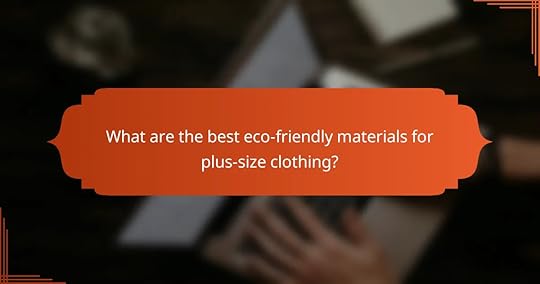
The best eco-friendly materials for plus-size clothing include organic cotton, Tencel (lyocell), and recycled polyester. These fabrics not only reduce environmental impact but also provide comfort and style for plus-size individuals.
Organic cottonOrganic cotton is grown without synthetic pesticides or fertilizers, making it a sustainable choice for plus-size clothing. This material is soft, breathable, and hypoallergenic, which is ideal for sensitive skin.
When shopping for organic cotton garments, look for certifications such as GOTS (Global Organic Textile Standard) to ensure the product meets environmental and social criteria. Brands often offer a range of styles, from casual wear to more formal options.
Tencel (lyocell)Tencel, or lyocell, is made from sustainably sourced wood pulp, primarily from eucalyptus trees. This fabric is known for its silky feel, moisture-wicking properties, and biodegradability, making it a great eco-friendly option for plus-size clothing.
Consider Tencel garments for their drape and comfort, especially in warmer climates. They often come in various styles, providing versatility for different occasions. Look for brands that highlight their sustainable practices in sourcing and production.
Recycled polyesterRecycled polyester is created from post-consumer plastic waste, such as bottles, reducing landfill impact and conserving resources. This material is durable, lightweight, and often moisture-resistant, making it suitable for activewear and casual clothing.
When choosing recycled polyester clothing, check for certifications like the Global Recycled Standard (GRS) to ensure the fabric’s sustainability. Many brands are now offering stylish plus-size options, allowing for both fashion and eco-consciousness.
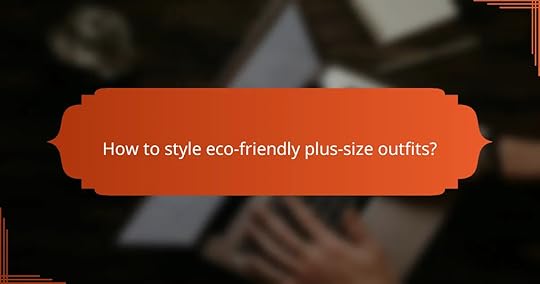
Styling eco-friendly plus-size outfits involves selecting sustainable materials and flattering cuts that enhance your shape while being kind to the planet. Focus on versatile pieces that can be mixed and matched, allowing for creativity and comfort in your wardrobe.
Layering techniquesLayering is essential for creating stylish plus-size outfits that are both functional and fashionable. Start with a fitted base layer, such as a sustainable cotton or bamboo top, and add a flowy cardigan or an oversized jacket for dimension. Aim for a balance between fitted and loose pieces to enhance your silhouette.
Consider using lightweight fabrics that breathe well, especially in warmer climates. For colder months, opt for thicker, eco-friendly materials like recycled wool or organic cotton. Remember to play with lengths; longer layers can elongate your figure, while shorter ones can highlight your waist.
Accessorizing with sustainable jewelrySustainable jewelry can elevate your eco-friendly plus-size outfits while making a statement. Look for pieces made from recycled materials, ethically sourced gemstones, or artisan-crafted items that support local communities. These accessories not only enhance your outfit but also reflect your commitment to sustainability.
When accessorizing, consider the scale of your jewelry in relation to your outfit. Larger, bold pieces can complement simpler outfits, while delicate items work well with more intricate designs. Aim for a cohesive look by choosing colors and materials that harmonize with your clothing palette.
Mixing textures for visual interestMixing textures is a powerful way to add depth to your eco-friendly plus-size outfits. Combine soft fabrics like organic cotton with sturdier materials such as linen or hemp to create a visually appealing contrast. This technique can draw attention to your best features while keeping the overall look dynamic.
Experiment with different textures by pairing a chunky knit sweater with a sleek, satin skirt or combining a textured top with smooth trousers. Be mindful of the color palette; sticking to a cohesive color scheme can help unify the various textures and create a polished appearance.

Eco-friendly plus-size fashion prioritizes comfort through thoughtful design and material choices. Key features include breathable fabrics, stretchy materials for ease of movement, and inclusive sizing that enhances fit.
Breathable fabricsBreathable fabrics are essential for comfort, especially in warmer climates. Materials like organic cotton, linen, and Tencel allow air circulation, reducing sweat and discomfort. Look for garments labeled as moisture-wicking to help keep you dry.
When shopping, consider the weight of the fabric; lighter materials are typically more breathable. Additionally, check for certifications like GOTS (Global Organic Textile Standard) to ensure the sustainability of the fabric.
Stretchy materials for movementStretchy materials, such as spandex blends, provide flexibility and comfort, allowing for a full range of motion. This is particularly important for plus-size fashion, where fit and ease of movement can significantly impact wearability.
Opt for clothing with at least 5-10% spandex or elastane for a comfortable stretch. This ensures that the garment retains its shape while accommodating body movements, making it ideal for both casual and active wear.
Inclusive sizing for better fitInclusive sizing is crucial in eco-friendly plus-size fashion, as it ensures that a diverse range of body types can find well-fitting options. Brands that offer extended size ranges often consider body shape variations, leading to more flattering fits.
When choosing clothing, pay attention to size charts and customer reviews for insights on fit. Some brands may use unique sizing systems, so understanding their specific measurements can help you select the best size for your body type.

When selecting eco-friendly fashion, consider the brand’s sustainability practices, material sourcing, and certifications. These factors help ensure that your clothing choices support environmentally responsible production and ethical labor practices.
Brand sustainability practicesEvaluate how brands approach sustainability by looking for transparency in their operations. Check if they have clear policies on waste reduction, energy use, and carbon emissions. Brands that engage in circular fashion, such as recycling or upcycling materials, often demonstrate a stronger commitment to sustainability.
Additionally, consider whether the brand supports fair labor practices. Certifications like Fair Trade or membership in organizations that promote ethical labor can indicate a brand’s dedication to both environmental and social responsibility.
Material sourcing and certificationsFocus on the materials used in the clothing, as this greatly impacts its environmental footprint. Look for natural fibers like organic cotton, linen, or Tencel, which are generally more sustainable than conventional materials. Synthetic fabrics made from recycled plastics can also be a good option, reducing waste in landfills.
Certifications such as Global Organic Textile Standard (GOTS) or OEKO-TEX can help you identify truly eco-friendly materials. These labels ensure that textiles meet rigorous environmental and safety standards, providing peace of mind about your purchases.



